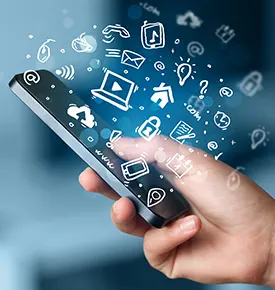Smartphones are amazing devices that allow us to stay connected to the internet, make calls, and take pictures and videos. They are constantly evolving and becoming more powerful, with new features and capabilities being added all the time. In the near future, we can expect even more amazing things from smartphones, as they continue to get more and more advanced. Here are some of the most futuristic technologies that will soon be available on smartphones.
Augmented Reality
The article discusses the potential for smartphone technology to develop in the near future. It cites examples such as the development of augmented reality (AR), which is the integration of digital information with the user's environment in real time. The article also discusses the potential for 5G technology, which would provide significantly faster data speeds, and the possibility of using blockchain to secure data. While these technologies are still in development, they have the potential to revolutionize the way we use our smartphones and change the way we interact with the world around us.
Virtual Reality
A new study has found that the average person spends more than three hours a day on their smartphone.
With the advent of new and more powerful processors, augmented reality (AR) and virtual reality (VR) are now within reach of the everyday consumer. Combined, these technologies have the potential to completely change the way we interact with the world around us.
AR is a technology that superimposes computer-generated images on top of real-world surroundings, while VR completely immerses the user in a simulated environment.
While AR and VR have been around for a while, they have only recently become accessible to the average consumer thanks to advances in smartphone technology.
One of the most popular VR platforms is the Oculus Rift, which was acquired by Facebook in 2014 for $2 billion. The Rift uses a headset and sensors to track the user’s head movements and provide a realistic 3D experience.
Another VR platform is the HTC Vive, which was developed in partnership with Valve Corporation. The Vive uses two handheld controllers and sensors that are placed around the room to track the user’s movements.
Google has also entered the VR market with its Daydream platform. Daydream is a software platform that runs on Android and is compatible with a range of VR headsets and controllers.
While VR is still in its early stages, it has the potential to change the way we interact with the world around us. For example, VR could be used for educational purposes, such as giving students a virtual tour of the inside of a cell or the solar system.
It could also be used for entertainment, such as allowing you to experience a concert or a sporting event from the comfort of your own home.
And VR could also have a significant impact on the way we shop. For example, you could try on clothes virtually before making a purchase, or you could test drive a car without ever leaving the showroom.
The possibilities for VR are endless, and it is likely that we will see a surge in adoption in the coming years.
Artificial Intelligence
The smartphone: futuristic technologies soon to be available article talks about the different ways that artificial intelligence is being used to make smartphones more efficient. One way is by using it to predict what the user wants to do next. Another way is to use it to help the user manage their time better. It can also be used to help the user find information faster and more accurately.
5G
In the near future, the fifth generation of wireless technology, or , will be available to consumers. This upgrade promises much faster download and upload speeds, as well as reduced latency. This will be a major improvement over the current 4G LTE networks, which are already quite fast. In addition to the speed increase, will also allow for more data to be transmitted over the airwaves. This will be essential for the increasing number of people who are using their smartphones for data-intensive tasks such as streaming video and gaming. The rollout of is expected to begin in 2019, and it will likely take several years for the network to be fully deployed.
Foldable Phones
A new smartphone technology that is likely to become available in the near future is the foldable phone. This type of phone would be able to fold up into a small, pocket-sized device, making it much more convenient to carry around than a traditional smartphone. The foldable phone would also be more durable, as the flexible display would be less likely to break if dropped.
The main advantage of a foldable phone over a traditional smartphone is the fact that it would be much more compact and easy to carry around. It would also be less likely to break if dropped, as the display would be flexible.
However, there are also some potential disadvantages to this new technology. For example, the foldable phone could be more expensive than a traditional smartphone, and the flexible display could be more susceptible to scratches.
Overall, the foldable phone is a new smartphone technology that has the potential to revolutionize the way we use our phones. It would be more compact and convenient to carry around, and the flexible display would make it more durable. However, the foldable phone could also be more expensive and susceptible to scratches.
